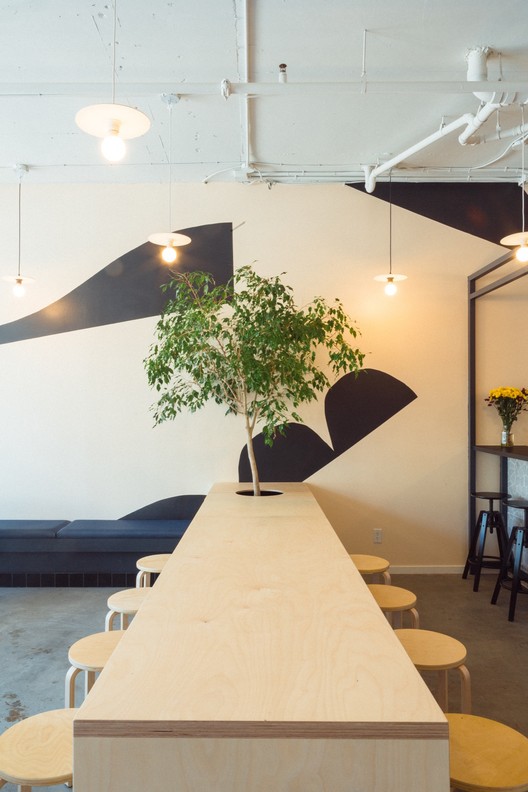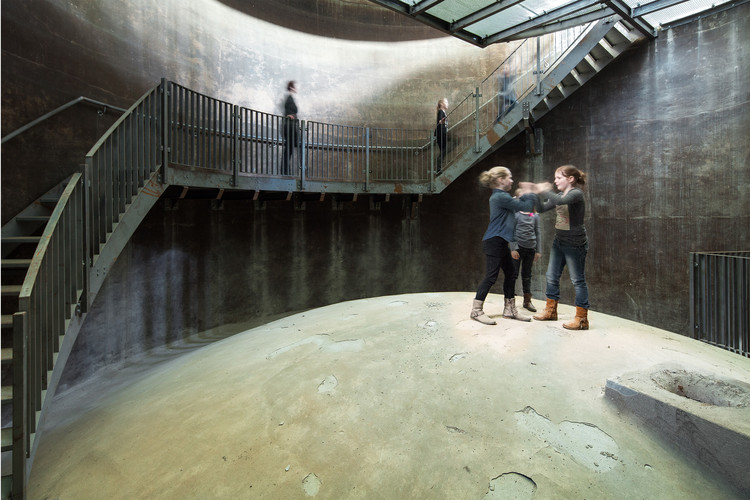Shipwreck Lodge Nina Maritz Architects
2018-09-18 02:00
© Denzel Bezuidenhoudt
(c)DenzelBezuidenhoudT


架构师提供的文本描述。受邓尼丁之星沉没的幸存者和荒凉而严酷的骷髅海岸景观的影响,建筑师们试图在他们的沉船小屋设计(以建筑概念命名)中捕捉掩蔽和暴露之间的对比。这些小木屋被想象成由幸存者们拼凑而成的碎片,作为抵御无情的风和烈日的避难所,木屋沿着沙丘的边缘展开,就像一支列在地平线上的船队。
Text description provided by the architects. Inspired by the deprivations endured by survivors from the foundered Dunedin Star and the desolate and harsh Skeleton Coast landscape, the architects tried to capture the contrast between shelter and exposure in their Shipwreck Lodge design (named after the architectural concept). Conceived of as abstracted wreckage fragments put together by survivors as shelter against the relentless wind and searing sun, the cabins are spread out along the dune edge like a listing flotilla against the skyline.
Text description provided by the architects. Inspired by the deprivations endured by survivors from the foundered Dunedin Star and the desolate and harsh Skeleton Coast landscape, the architects tried to capture the contrast between shelter and exposure in their Shipwreck Lodge design (named after the architectural concept). Conceived of as abstracted wreckage fragments put together by survivors as shelter against the relentless wind and searing sun, the cabins are spread out along the dune edge like a listing flotilla against the skyline.
© Denzel Bezuidenhoudt
(c)DenzelBezuidenhoudT


睡眠空间与浴室之间有一个小链接,以创造隐私。浴室的锋利弓使机舱周围盛行的西南风转向,以减少噪音和对结构的冲击。大窗户向外眺望远处的海景,只有最少的外部要素。许多家具都是内置的,类似于旧帆船的内饰。主休息室和餐厅是一个大得多的船舱版本,内置的长椅和座椅召回船只的铺位和舱壁。客人们从游戏驱动器等活动返回,去看适应沙漠的野生动物,来到一个温暖而坚实的避风港。
Sleeping spaces are separated from the bathrooms with a small link, to create privacy. The sharp bow of the bathroom diverts the prevailing south-west wind around the cabin to reduce the noise and battering the structure has to take. Large windows look out onto the distant sea view, with a minimum of external elements. Much of the furniture is built-in, similar to the interiors of sailing ships of old. The main lounge and dining area is a much larger version of the cabin, with built-in benches and seats recalling vessel bunks and bulkheads. Guests return from activities such as game drives to see desert-adapted wildlife to a warm and solid haven.
Sleeping spaces are separated from the bathrooms with a small link, to create privacy. The sharp bow of the bathroom diverts the prevailing south-west wind around the cabin to reduce the noise and battering the structure has to take. Large windows look out onto the distant sea view, with a minimum of external elements. Much of the furniture is built-in, similar to the interiors of sailing ships of old. The main lounge and dining area is a much larger version of the cabin, with built-in benches and seats recalling vessel bunks and bulkheads. Guests return from activities such as game drives to see desert-adapted wildlife to a warm and solid haven.
Main Building Plan
主要建筑图则


该设计是一个微妙的平衡之间的唤起,但不太衍生,周围的门洞窗户周围和一个破石伸出一些乐趣。为了迎接一间20张床的豪华旅舍对环境的影响几乎为零的挑战,我们在工地外用面板预制造了一些建筑结构,并进行了3次换乘,以便在现场组装。这使得建筑工人的数量和工地上的废品量降到最低。太阳能发电、太阳能热水器、燃气烹饪和下水道生物消化器只是为尽量减少影响而采取的一些绿色战略。
The design is a fine balance between being evocative, but not too derivative, with here and there around porthole window and a broken spar sticking out for some fun. To meet the challenging brief of a 20-bed luxury lodge with almost zero environmental impact, structures were pre-manufactured in panels off-site and went through 3 changes of transport to be assembled on site. This minimized the number of construction workers and the amount of waste on site. Solar power, solar water heating, gas cooking and bio-digesters for sewer are only some of the green strategies applied to minimize impact.
The design is a fine balance between being evocative, but not too derivative, with here and there around porthole window and a broken spar sticking out for some fun. To meet the challenging brief of a 20-bed luxury lodge with almost zero environmental impact, structures were pre-manufactured in panels off-site and went through 3 changes of transport to be assembled on site. This minimized the number of construction workers and the amount of waste on site. Solar power, solar water heating, gas cooking and bio-digesters for sewer are only some of the green strategies applied to minimize impact.
© Denzel Bezuidenhoudt
(c)DenzelBezuidenhoudT


Cabin Plan
舱室规划


© Michael Turek
迈克尔·图雷克


在这些恶劣的沿海条件下,木材被选为客人设施中最耐用的材料,也是25年特许权期结束时最容易移除的木材,是种植地。双层外壳是用回收的水瓶纤维毯绝缘的,外包层是用革命性的新木钉系统固定的,以尽量减少使用金属螺钉(这很容易生锈,造成问题的浪费)。内部覆层从定向绞线板(OSB)和松木板到潮湿地区的凹凸板。
For the guest facilities, timber was selected as the most durable material in these harsh coastal conditions, as well as the most easily removable at the end of the 25 year concession period, and is plantation grown. The double-skin envelope is insulated with a recycled water-bottle fiber blanket and the exterior cladding is fixed with a revolutionary new timber nailing system to minimize the use of metal screws (which would rust easily and create problematic waste). Interior cladding varies from oriented strand board (OSB) and pine planking to saligna planks in wet areas.
For the guest facilities, timber was selected as the most durable material in these harsh coastal conditions, as well as the most easily removable at the end of the 25 year concession period, and is plantation grown. The double-skin envelope is insulated with a recycled water-bottle fiber blanket and the exterior cladding is fixed with a revolutionary new timber nailing system to minimize the use of metal screws (which would rust easily and create problematic waste). Interior cladding varies from oriented strand board (OSB) and pine planking to saligna planks in wet areas.
© Denzel Bezuidenhoudt
(c)DenzelBezuidenhoudT


对于房子后面的设施和工作人员设施,从沃尔维斯湾港装运的集装箱被改装在场外,并安装在庭院结构中的预制混凝土桩上,以建立风挡区域。与内陆小屋不同的是,所有活动都必须在室内进行,因为风太大,不能在室外待很长时间。尽管建筑师们在一些与旅游有关的项目(如住宿)上有着悠久的经验,但沉船旅馆由于地处偏远、环境恶劣和使用完整的木材结构而特别具有挑战性,而这在纳米比亚根本不常见。它需要一个伟大的团队的技能来成功地完成整个项目。
For the back-of-house and staff facilities, shipping containers from the harbor of Walvis Bay were adapted off-site and installed on pre-cast concrete piles in courtyard formations to create wind-sheltered areas. Unlike inland lodges, all activities have to take place indoors, as the wind is too harsh to be outside for very long. Despite the architects’ longstanding experience on several tourism-related projects such as lodges, the Shipwreck Lodge was particularly challenging due to its remoteness, the harsh environmental conditions and the use of full timber structures, which is not at all common in Namibia. It needed the skills of a great team to pull off the entire project successfully.
For the back-of-house and staff facilities, shipping containers from the harbor of Walvis Bay were adapted off-site and installed on pre-cast concrete piles in courtyard formations to create wind-sheltered areas. Unlike inland lodges, all activities have to take place indoors, as the wind is too harsh to be outside for very long. Despite the architects’ longstanding experience on several tourism-related projects such as lodges, the Shipwreck Lodge was particularly challenging due to its remoteness, the harsh environmental conditions and the use of full timber structures, which is not at all common in Namibia. It needed the skills of a great team to pull off the entire project successfully.
© Michael Turek
迈克尔·图雷克


Main Building Section
主厂房


© Denzel Bezuidenhoudt
(c)DenzelBezuidenhoudT






























































Architects Nina Maritz Architects
Location Hoarusib River, Namibia
Area 875.0 m2
Project Year 2018
Photographs Shawn van Eeden, Denzel Bezuidenhoudt, Michael Turek
Category Lodging
Manufacturers Loading...
























